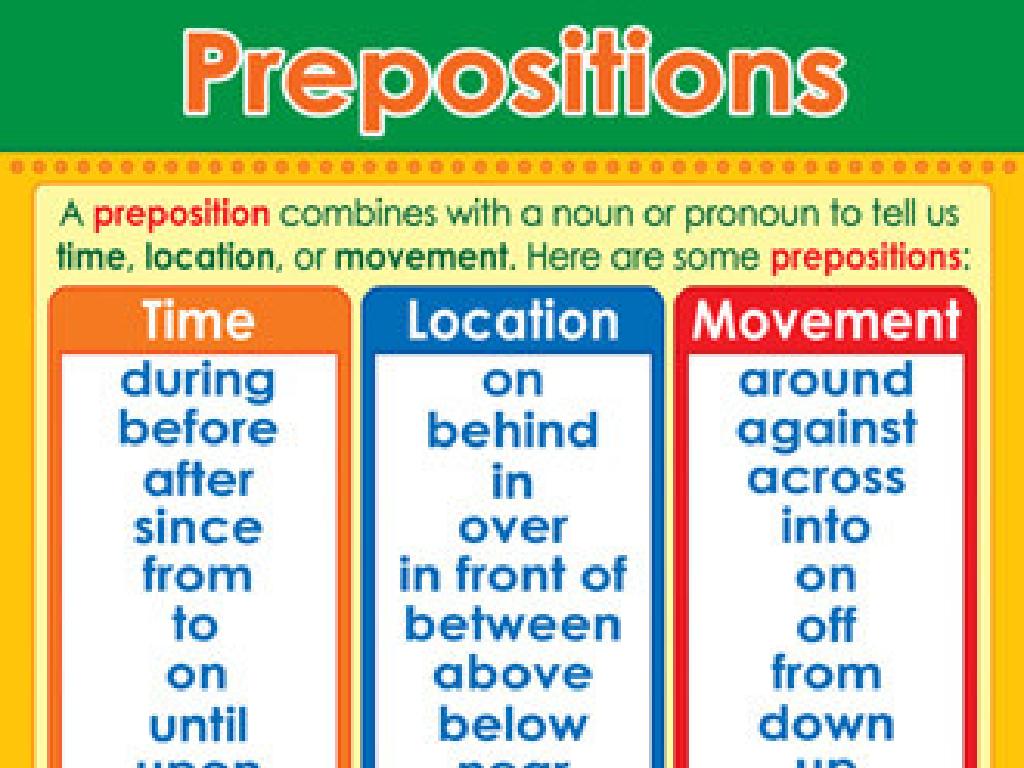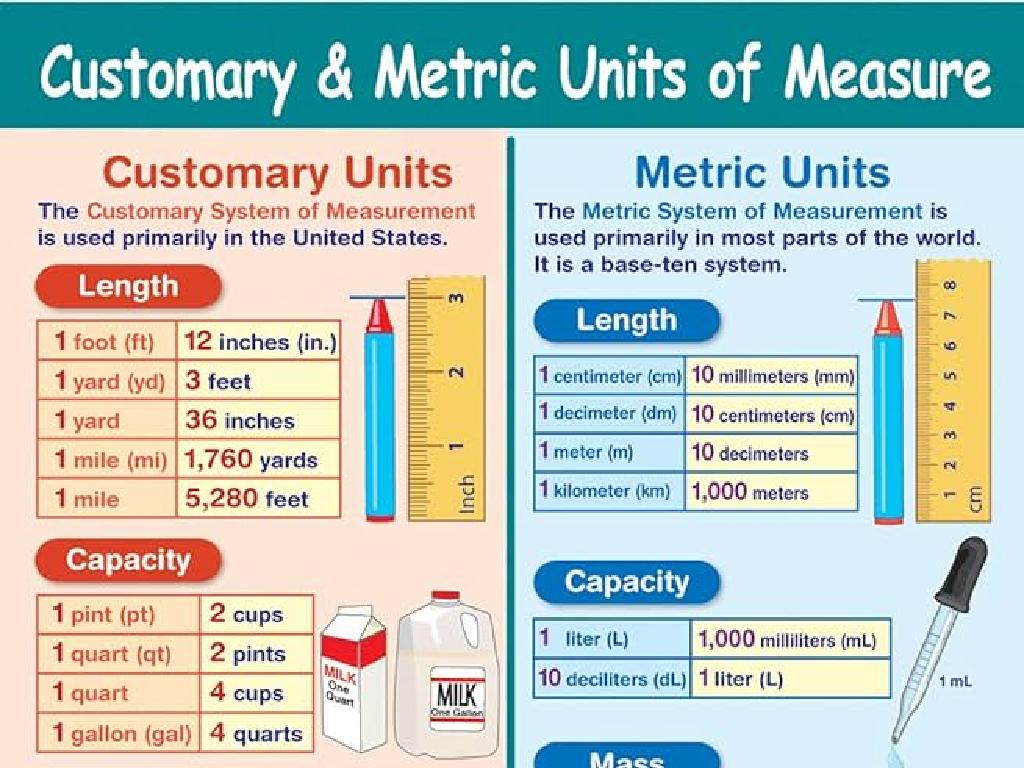The Bill Of Rights
Subject: Arts and humanities
Grade: High school
Topic: Constitution 104
Please LOG IN to download the presentation. Access is available to registered users only.
View More Content
Constitution 104: The Bill of Rights
– Introduction to the U.S. Constitution
– The foundational document outlining the government’s structure and citizens’ rights.
– Significance of the Bill of Rights
– The first ten amendments guaranteeing essential freedoms and legal protections.
– Overview of today’s lesson
– Learning objectives
– Understand the historical context and contemporary relevance of these amendments.
|
This slide introduces students to the United States Constitution, with a focus on the Bill of Rights. Begin by discussing the Constitution as the supreme law that outlines the national frame of government and the rights of the citizens. Emphasize the significance of the Bill of Rights, which comprises the first ten amendments and serves as a crucial document protecting individual liberties and justice. Provide an overview of the lesson to give students a roadmap of what to expect and the learning objectives they should aim to achieve by the end of the session. The objectives include understanding the historical context of the Bill of Rights, recognizing its importance in current times, and being able to identify and explain each of the ten amendments.
Understanding the Bill of Rights
– Definition of the Bill of Rights
– A charter of fundamental liberties promised to citizens
– First ten amendments to the Constitution
– They outline individual freedoms and legal protections
– Historical context of its creation
– Created to address Anti-Federalist concerns during the ratification of the Constitution
|
The Bill of Rights is a pivotal element of American democracy, comprising the first ten amendments to the U.S. Constitution. It was introduced to guarantee essential rights and civil liberties, such as freedom of speech, religion, and press, as well as to set rules for due process of law and reserve powers to the people and the states. The historical context is crucial, as these amendments were a compromise to satisfy the Anti-Federalists’ fears of an overly powerful central government. This slide aims to provide students with a foundational understanding of the Bill of Rights, its purpose, and its significance in the broader narrative of American history and the Constitution.
First Amendment Freedoms
– Five freedoms of the First Amendment
– Speech, religion, press, assembly, petition
– Examples of First Amendment rights
– Protests for social change, press uncovering scandals
– Role in democracy
– Essential for informed citizenry and accountability
– Challenges to these freedoms
|
This slide aims to delve into the First Amendment of the U.S. Constitution, which is pivotal in safeguarding liberties fundamental to the American democratic system. The five freedoms it protects are freedom of speech, religion, press, assembly, and petition. Provide historical and contemporary examples, such as civil rights protests and investigative journalism, to illustrate these rights in action. Discuss how these freedoms support the functioning of a democracy by ensuring an informed public and holding those in power accountable. Highlight the ongoing debates and legal challenges that test the limits and interpretations of these freedoms. Encourage students to think critically about the role these rights play in their own lives and in the fabric of society.
Exploring Amendments 2-10 of the Bill of Rights
– 2nd Amendment: Right to bear arms
– Allows for the possession and use of weapons
– 3rd-4th Amendments: Quartering & searches
– No soldier quartering without consent; protects against unreasonable searches
– 5th-8th Amendments: Legal protections
– Rights in criminal cases, due process, fair trials, and protection from cruel punishment
– 9th-10th Amendments: Other rights & powers
– Recognize other rights and affirm states’ powers
|
This slide provides a concise overview of the Second through Tenth Amendments, which are crucial for protecting individual liberties within the United States. The Second Amendment is often debated in the context of gun control laws. The Third and Fourth Amendments address the privacy and property rights of citizens, preventing the government from overreach. The Fifth through Eighth Amendments offer a range of legal protections, ensuring due process and fair treatment in the judicial system. Lastly, the Ninth and Tenth Amendments serve as a catch-all, ensuring that the enumeration of certain rights in the Constitution does not undermine other rights and that powers not delegated to the federal government are reserved to the states or the people. Encourage students to think critically about how these amendments apply in current events and legal discussions.
Case Studies: The Bill of Rights in Action
– Key Supreme Court case studies
– Explore cases like Miranda v. Arizona, which defined the right to remain silent
– Evolution of the Bill of Rights
– How interpretations have changed over time, reflecting societal shifts
– Analyze case impacts on society
– Discuss the societal changes post rulings, e.g., increased protection of individual rights
|
This slide aims to delve into the practical application of the Bill of Rights through significant Supreme Court cases. Students should examine how these landmark cases have shaped the understanding and enforcement of the Bill of Rights. Highlight the evolution of legal interpretations as they adapt to new societal norms and challenges. Encourage students to think critically about the broader impact of these cases on American society, such as how they have influenced civil liberties and the justice system. Provide a historical context for each case, and discuss the long-term implications of the court’s decisions. This will help students appreciate the dynamic nature of constitutional law and its relevance to contemporary issues.
The Bill of Rights in Modern Times
– Current events and the Bill of Rights
– Explore how recent news stories relate to the Bill of Rights.
– Debating the Bill of Rights’ relevance
– Discuss how these amendments apply to today’s societal issues.
– Critical thinking on amendments’ role
– Analyze the importance of the Bill of Rights in protecting freedoms.
– Reflect on rights in the 21st century
– Consider how the Bill of Rights impacts our daily lives now.
|
This slide aims to connect the historical context of the Bill of Rights to current events, encouraging students to see the living relevance of these amendments. Students should be prompted to think critically about how each right plays a role in contemporary society and legal issues. Encourage them to bring examples from recent news that illustrate the application or challenges to the Bill of Rights. The debate should focus on whether the Bill of Rights still serves its intended purpose or if it requires reinterpretation. This discussion will help students appreciate the enduring impact of the Bill of Rights and its significance in their lives as citizens.
Class Activity: The Bill of Rights in Our Lives
– Break into small discussion groups
– Choose one amendment to focus on
– Develop a real-life scenario application
– Example: 1st Amendment rights used in a peaceful protest
– Create a poster or short presentation
– Visual aids or storytelling to illustrate the scenario
|
This activity is designed to help students understand the practical implications of the Bill of Rights in everyday life. By working in small groups, students can engage in deeper discussions and explore the nuances of each amendment. The task of choosing a specific amendment and creating a real-life scenario encourages them to think critically about how these laws affect them and their community. The creative aspect of making a poster or presentation allows for a diversity of expression and can cater to different learning styles. As a teacher, facilitate the group formation, ensure each group chooses a different amendment for variety, and provide materials for the poster creation. Possible scenarios could include freedom of speech at a school event, the right to privacy in digital communications, or the right to a fair trial. Encourage students to be respectful and thoughtful in their discussions and presentations.
Reflecting on the Bill of Rights
– Recap of today’s key points
– Open floor for questions
– Reflect on the Bill of Rights
– Consider how these amendments impact our daily lives and protect our freedoms.
– Discuss its significance
– Why is it crucial for a democratic society?
|
As we conclude today’s lesson on the Bill of Rights, it’s important to summarize the key points to reinforce student understanding. Allow students to ask any lingering questions or share comments to clarify their understanding. Encourage them to reflect on the significance of the Bill of Rights, not just as a historical document, but as a living part of our democracy that affects their lives every day. Discuss its role in safeguarding individual freedoms and ensuring a balance of power. This reflection will help students appreciate the relevance of the Constitution in contemporary society and their role as informed citizens.





